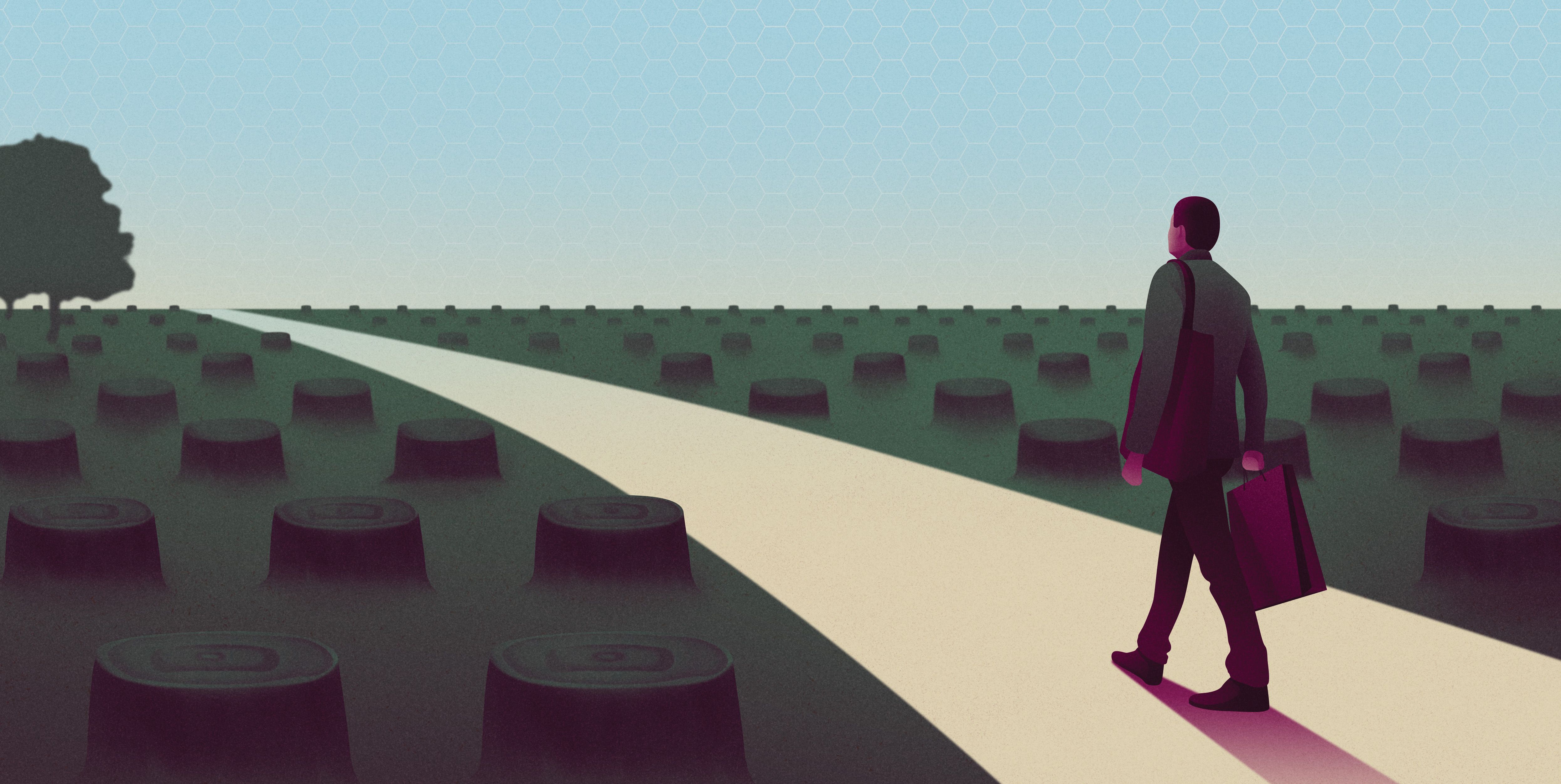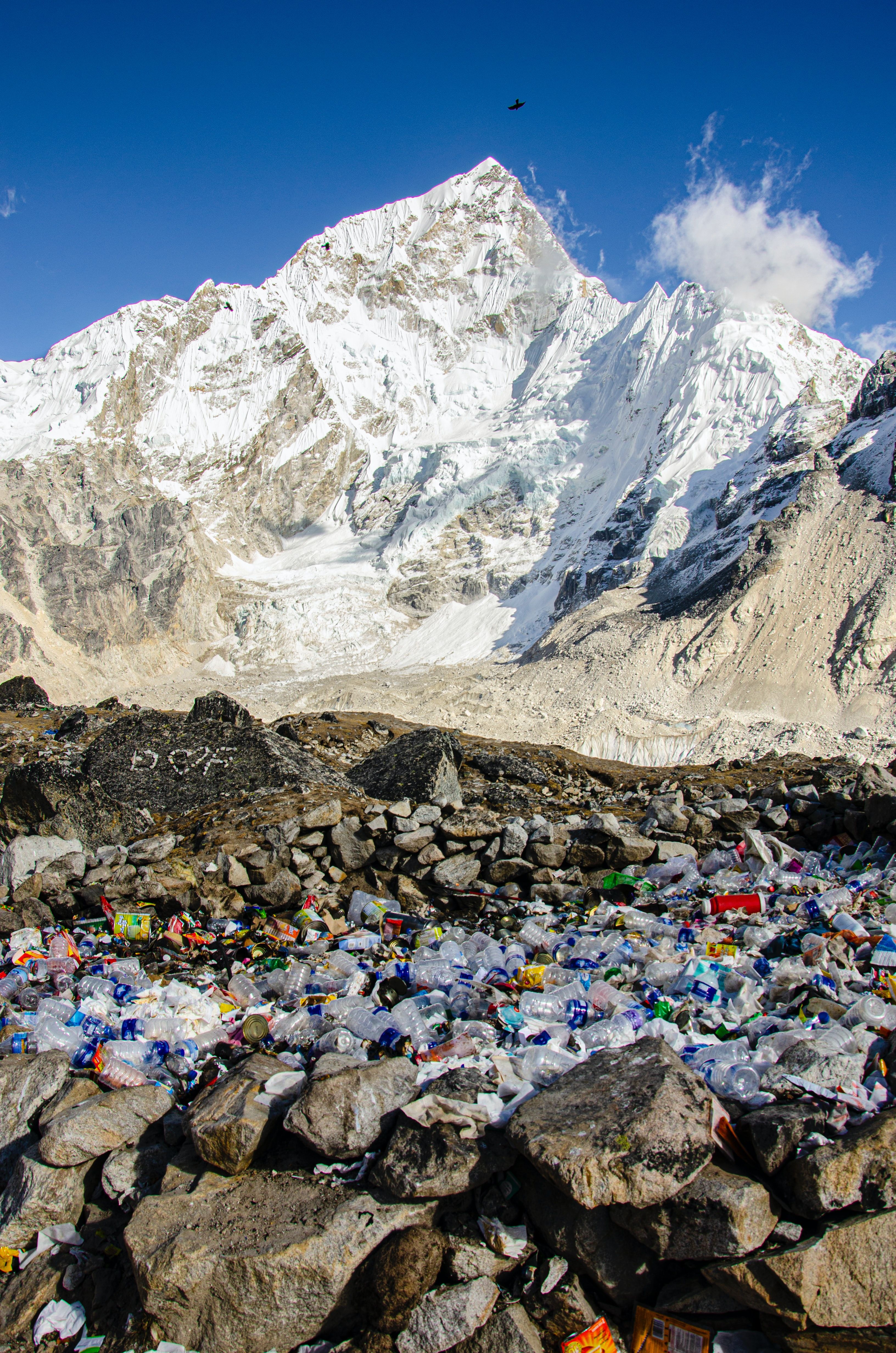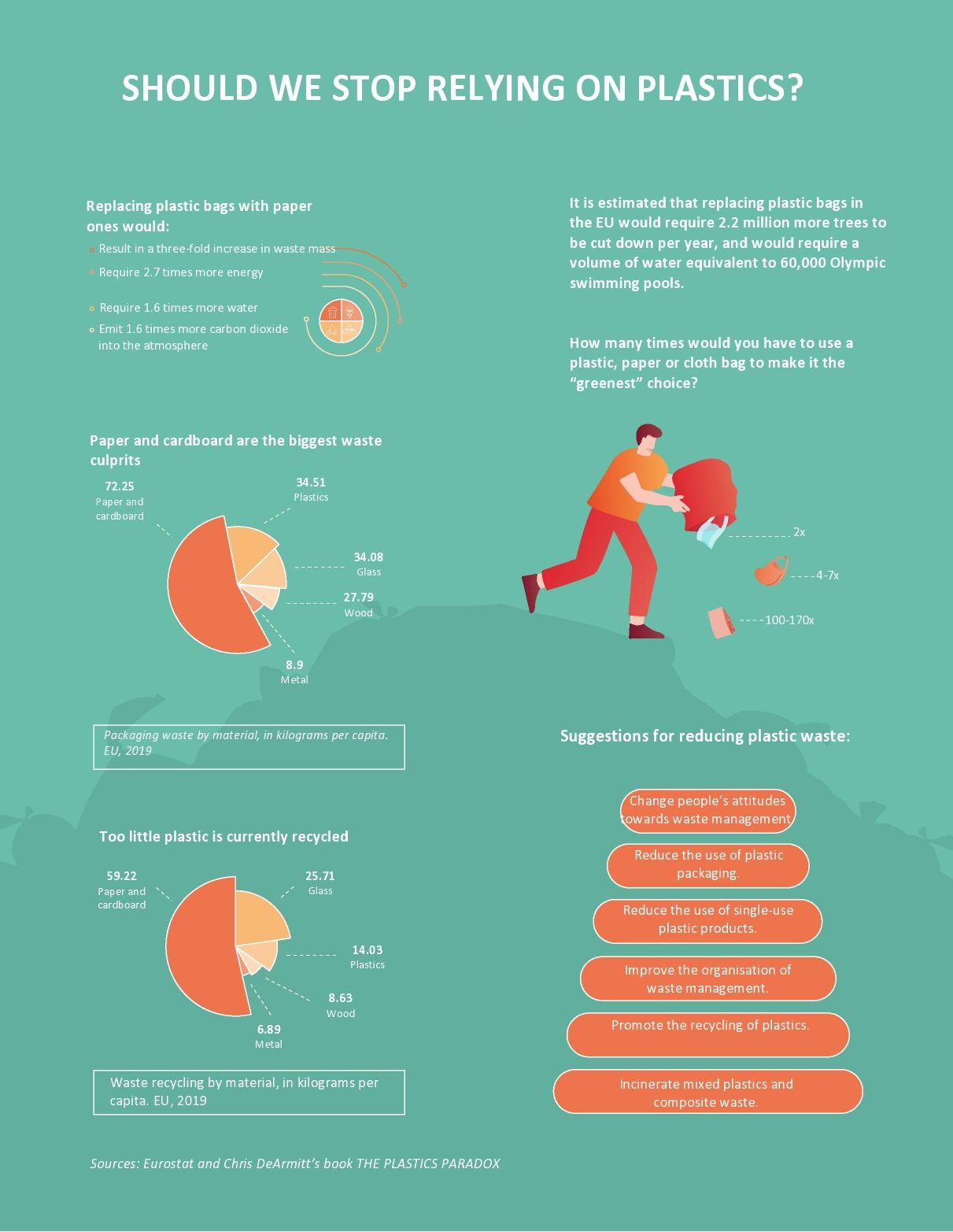Wait... Can Plastics Be Good for the Environment?
 Substituting a plastic straw with a paper or metal one only has a minor impact on reducing environmental pollution. And a supposedly eco-friendly cloth shopping bag can be more harmful to the environment than a conventional plastic bag unless it is reused hundreds of times. In other words, many of our ideas concerning plastics and the environment are incorrect and impede the fight against global warming.
Substituting a plastic straw with a paper or metal one only has a minor impact on reducing environmental pollution. And a supposedly eco-friendly cloth shopping bag can be more harmful to the environment than a conventional plastic bag unless it is reused hundreds of times. In other words, many of our ideas concerning plastics and the environment are incorrect and impede the fight against global warming.
According to Prof. Ričardas Makuška, a renowned Chemist and Head of the Department of Polymer Chemistry at the Faculty of Chemistry and Geosciences of Vilnius University, plastics remain the optimal choice as packaging material. Alternative materials such as cloth or paper bags, paper packaging or biodegradable plastics are more polluting and contribute to the greenhouse effect. The majority of the plastic pollution on land and in oceans is not caused by the materials but by human mismanagement.
Plastics are accumulating everywhere
In the 20th century, scientists discovered how to make polymers, which are the main components of plastics. These materials have triggered a technological revolution that has led to astonishing advances in our quality of life. Clean drinking water is supplied through plastic pipes and electricity flows through plastic-insulated wires. Plastic packaging plays a crucial role in safeguarding food from microbiological contamination and oxidative processes, thereby extending the shelf life of food products that must reach supermarket shelves. Nevertheless, these plastic packaging materials have become the target of public criticism.
“It is known that plastics are accumulating everywhere: in streets, on beaches, and in seas and oceans. Therefore, we have created a problem that was not originally present in nature, causing harm to both the natural environment and ourselves,” said the professor.
Although there are many plastic products, plastic bags are the most often to be “judged” in the public sphere, where they are attributed with both existing and non-existing “sins”. There have been proposals to completely eliminate plastic packaging r, replacing it with supposedly more environmentally friendly alternatives such as paper, cloth, or biodegradable materials. Chemists have long shared arguments against the “greenness” of cotton bags or biodegradable packaging, yet these arguments seldom reach the general public. Recently, there has been a noticeable breakthrough with the publication of Chris DeArmitt’s book “The Plastics Paradox” (Phantom Plastics LLC, 2020), which vividly and emotionally demonstrates how plastics have been unjustly and unscientifically labelled as the most polluting material in the world. Prof. R. Makuška explained that this book has also helped him organise his thoughts and put together arguments that there are no substitutes for conventional plastic packaging.
Life Cycle Assessment that has changed the way we think
The professor acknowledges that plastic waste is harmful to the environment if not handled appropriately. Nonetheless, the production of any product, whether it plastic or paper, also poses harm to the environment. Thus, the environmental impact of a product should be assessed holistically.
This was done approximately twenty years ago with the development of the Life Cycle Assessment (LCA). The LCA is a tool for evaluating the true “greenness” of products. It helps determine the environmental impact associated with the production process and usage of a product, including the raw materials, energy, waste, by-products, transportation, recovery and disposal. Typically, the factors assessed are the energy consumption, greenhouse gas emissions (carbon dioxide and methane) and six additional pollutants: volatile organic compounds, carbon monoxide, nitrogen oxides, sulphur oxides, large particulate matter (greater than 10 microns) and small particulate matter (less than 2.5 microns).
Which bag is the “greenest”?
In an attempt to promote sustainability, there has been a recent shift from plastic packaging to paper and cardboard alternatives. However, it is important to note, that paper bags are considerably thicker than plastic bags and require significantly more energy and water for production. Replacing 1 kg of plastics requires 3-4 kg of other materials and generates twice as much waste. For instance, the production of a single sheet of A4 paper consumes approximately 20 litres of water, whereas only 5.3 litres are needed to manufacture a PET plastic bottle. Moreover, paper bags lack mechanical durability, are vulnerable to moisture and are prone to staining, and their production contributes to deforestation. “So what are the advantages of using these bags?” asked the professor.
What about cotton? Surprisingly, the LCA shows that cotton bags are even more harmful to the environment, especially when made from organic cotton. Various studies indicate that a cotton bag would need to be used more than 100 times before it could match the environmental impact of single-use plastic bags.
When choosing between a paper bag and a plastic bag at the supermarket checkout, the more environmentally friendly option, according to an LCA study, is actually the plastic bag. However, it is advisable to reuse that plastic bag for multiple purchases by carrying it in your handbag. Prof. R. Makuška not only recommends this approach but also revealed that he personally follows the same practice.
“I usually carry my own plastic bag. Occasionally, I have to purchase one when I forget, but I refuse paper bags. There is no logical explanation for choosing a paper bag,” stated Professor R. Makuška from Vilnius University.
Problems with thin plastic bags
What about the ultra-lightweight (thin) plastic bags we use for weighing products like apples, cucumbers and potatoes? Several EU countries have implemented tax policies encouraging people to bring their own reusable bags. In the near future, Lithuania will also implement charges for taking home this type of plastic bags. Professor R. Makuška views the decision made by the Seimas positively, as taxing ultra-lightweight plastic bags could encourage people to reconsider whether it is truly necessary to use separate bags for items like a bunch of bananas or a courgette.
What distinguishes ultra-lightweight plastic bags from conventional plastic shopping bags? Shopping bags have thicker walls, usually of 40 or 50 microns . These shopping bags are often minimally soiled and easily separated in the waste stream, making them highly recyclable. On the other hand, ultra-lightweight plastic bags, with a thickness of less than 15 microns, weigh just a few grams and are usually coated with fats, proteins, and other substances.

According to the professor, these bags need to be washed before being recycled. This requires the use of detergents, and the water used to wash the bags needs to be treated to remove contaminants. All of this effort is put in for a few grams of plastic. This begs the question – is it worth it? Recycling these bags may actually lead to more environmental pollution than producing them from new raw materials.
Biodegradable plastics cannot solve the problem
A decade or two ago, there was a widespread belief that substituting conventional plastics with biodegradable plastics would be a good way to protect the environment. Biodegradable plastics are plastics that degrade relatively fast under natural or composting conditions in half a year, according to some standards. Biodegradable plastics can be of a natural origin (e.g. derivatives of starch), obtained through biotechnological and chemical methods using renewable materials like starch or sugar (e.g. polylactide), or can even be synthetic (e.g. polycaprolactone).
Unfortunately, the use of these biodegradable plastics is not a panacea. Firstly, the production of biodegradable plastics is more expensive as well as more polluting, and this contributes to the greenhouse effect. Secondly, recycling biodegradable plastics is challenging due to their susceptibility to degradation. Thirdly, biodegradable plastics do not degrade rapidly and completely; instead, the degradation require specific composting conditions, including elevated pressure and temperatures of 50-60° C. Finally, what purpose does it serve to allow biodegradable plastics to degrade under composting conditions, releasing carbon dioxide and, in some cases, methane? This only intensifies the greenhouse effect without providing any added value.
“Biodegradable plastics are therefore not the solution to this problem,” said the professor.
What about bioplastics?
The most important plastics for household use are polyethylene (PE), polypropylene (PP) and polyethylene terephthalate (PET). There is another category of plastics called “bioplastics”. These plastics that are manufactured using raw materials derived from either fully or partially renewable resources. In other words, they are not made from refined petroleum products but are instead sourced from substances as sugar or starch. For instance, starch can be used to produce ethanol, which, in turn, can be used to produce both PE and PET. Usually, the methods of producing bioPE and bioPET are more expensive and in some cases more environmentally polluting.
According to Prof. R. Makuška, bioPE and PE do not differ in terms of their properties, and the same applies to bioPET and PET. The biodegradability of these materials is also identical, meaning they do not effectively address environmental concerns.
How should plastic waste be disposed of correctly?
The scientist concurs that reducing the amount of plastic packaging is crucial to achieving greater sustainability, as producing less will result in reduced pollution. It is also a good idea to shift away from disposable tableware and other single-use plastic items. However, from a current scientific perspective, there may not be an alternative packaging material with a lower greenhouse impact than traditional plastics. This is because polyethylene (PE) and polypropylene (PP), being the polymers of the simplest structure, are the most cost-effective to produce and have the least environmental impact.

The professor unveiled that the larger issue lies within the plastic waste sorting system. It is essential to enhance the system to differentiate between ultra-lightweight plastic bags, food-contaminated packaging, and thick-walled plastic bags, as well as other clean plastic packaging. If there were a clear system for sorting plastic waste and efficient disposal opportunities, ordinary individuals could contribute to addressing this challenge.
“Professor Makuška stated that only once a clear sorting system is established, we can ensure a higher part of plastics is recycled and non-recyclable plastics are incinerated.
According to the professor, there is no need to fear incinerating plastics. However, it is important not to burn plastic waste in ovens or outside one's home. Instead, Combined Heat and Power (CHP) plants are designed for this purpose. Lithuania currently has three such plants in operation, located in Vilnius, Kaunas and Klaipėda. These plants incinerate non-recyclable plastic waste at temperatures of at least 850 °C, which minimizes the production of particulates and other harmful substances. If necessary, the plants also capture these harmful substances. Incinerating plastic waste using this method does produce carbon dioxide, but a comparable amount of carbon dioxide would be released if the plastics were to decompose naturally. Incinerating plastic waste in CHP plants generates both heat and electricity, meeting part of the city’s energy needs. It should be noted that plastic waste is highly combustible and produces a similar amount of energy as burning diesel or fuel oil.
“There is no need to fear environmental pollution from incinerating plastics. The power plant itself, along with environmental protection authorities monitoring air pollution, tracks data on carbon dioxide and other harmful emissions," said Prof. R. Makuška.
The solution is optimising the waste management system
“The solution to the plastic problem does not lie in developing better bioplastics or reverting to paper packaging, but rather in optimizing the waste management system to efficiently collect, sort, recycle, and incinerate plastic waste,” said the Vilnius University chemist.

For plastics to be recycled for reuse, it is crucial that products are manufactured using a single polymer. Therefore, we should eliminate the use of many types of plastics and focus on the main ones – polyethylene, polypropylene, and polyethylene terephthalate – as they are the easiest to recycle, sort and widely use in households, according to Prof. R. Makuška. Additionally, products should be durable to enable multiple recycling while reducing the reliance on single-use plastic items and packaging.
“Conventional plastics are the optimal choice from both an economic and environmental standpoint. They are inexpensive, and the packaging made from these plastics effectively protects perishable food. Additionally, they help reduce waste streams and contribute to the circular economy, leading to savings in raw materials. When plastic waste decomposes, it does not emit any toxic substances. The only drawback is that it takes a significantly long time to decompose. Improper disposal of plastic waste poses a threat to the environment, but this issue stems from human mismanagement rather than the inherent properties of plastics," stated Professor R. Makuška of Vilnius University.